Chris Smith
Hello, this week we meet the substance whose chemical claim to fame is that its quite literally hit a bum note in the past as a cure for constipation. But its explosive role isn't just confined to the colon because it's also the basis of incendriary bombs and even the existence of life on Earth. And to tell the story of magnesium, here's John Emsley.
John Emsley
It was once the destroyer of cities – now it's a saver of energy.
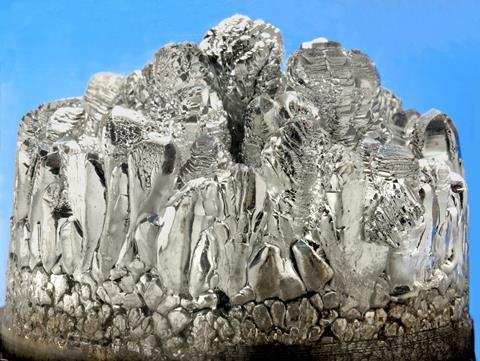
The summer of 1618 saw England gripped by drought, but as Henry Wicker walked across Epsom Common he was came across a pool of water from which thirsty cattle refused to drink. He found that the water tasted bitter and on evaporation it yielded a salt which had a remarkable effect: it acted as a laxative. This became the famous Epsom's salt (magnesium sulfate, MgSO4) and became a treatment for constipation for the next 350 years.
The first person to propose that magnesium was an element was Joseph Black of Edinburgh in 1755, and an impure form of metallic magnesium was produced in 1792 by Anton Rupprecht who heated magnesia (magnesium oxide, MgO) with charcoal. He named the element austrium after his native Austria. A small sample of the pure metal was isolated by Humphry Davy in 1808, by the electrolysis of moist MgO, and he proposed the name magnium based on the mineral magnesite (MgCO3) which came from Magnesia in Greece. Neither name survived and eventually it was called magnesium.
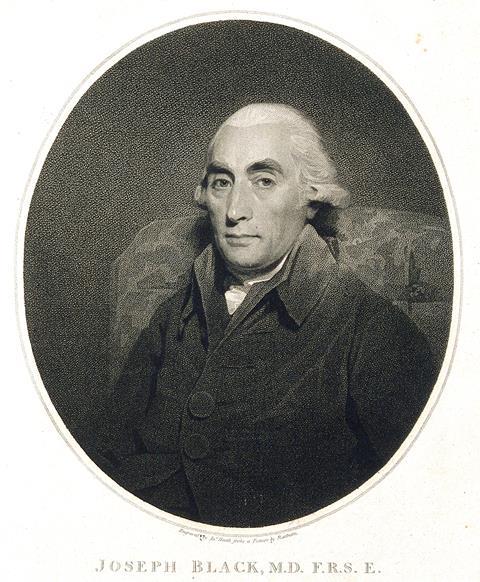
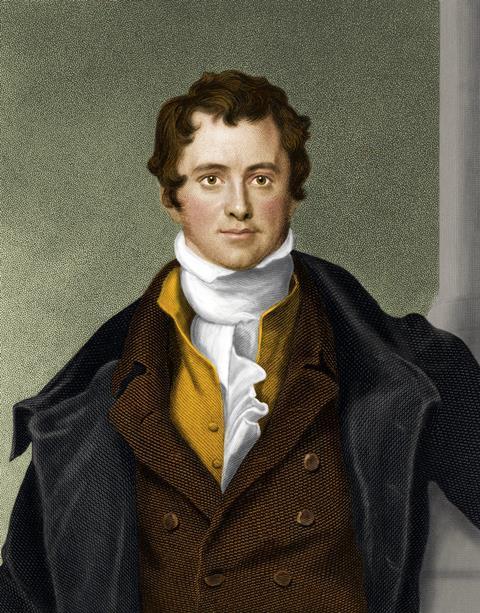
Magnesium is essential to almost all life on Earth – it is at the heart of the chlorophyll molecule, which plants use to convert carbon dioxide into glucose, and then to cellulose, starch, and many other molecules which pass along the food chain. Humans take in around 300 mg of magnesium per day and we need at least 200 mg, but the body has a store of around 25 g of this element in its skeleton so there is rarely a deficiency.
Almonds, brazil nuts, cashew nuts, soybeans, parsnips, bran, and even chocolate are all rich in magnesium. Some brands of beer contain a lot, such as Webster's Yorkshire Bitter – it may owe some of its flavour to the high levels of magnesium sulfate in the water used to brew it.

Magnesium is the seventh most abundant element in the Earth's crust, and third most abundant if the Earth's mantle is also taken into consideration because this consists largely of olivine and pyroxene, which are magnesium silicates. It is also abundant in sea water (1200 ppm) so much so that this was the source of magnesium for bombs in World War II. The metal itself was produced by the electrolysis of the molten chloride.
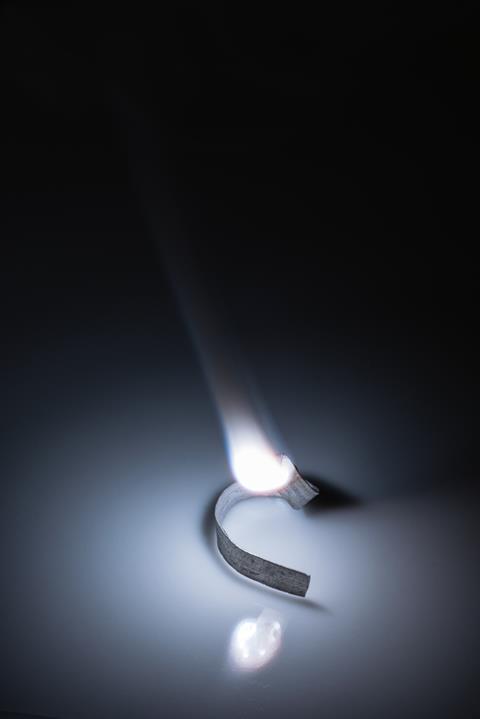
Once magnesium starts to burn it is almost impossible to extinguish, because it reacts exothermically with oxygen, nitrogen and water. It burns with a bright light and was used for photographic flash bulbs It made an ideal incendiary agent and in some air raids during World War II as many as half a million 2 kg magnesium bombs would be scattered over a city in the space of an hour. The result was massive conflagrations and firestorms. Bulk magnesium metal is not easily ignited so this had to be done by a thermite reaction at the heart of the bomb. The thermite reaction, between aluminium powder and iron oxide, releases more than enough heat to cause the magnesium casing of the bomb to burn fiercely.
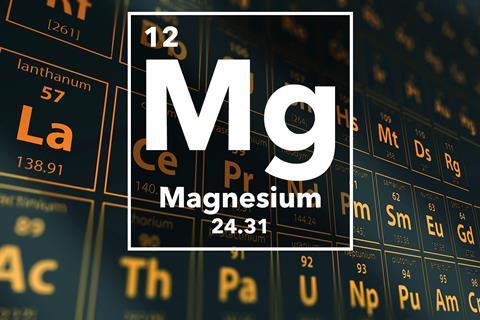
Many minerals are known which contain magnesium; but the main ones are dolomite (calcium magnesium carbonate, CaMg(CO3)2) and magnesite which are mined to the extent of 10 million tonnes per year. Magnesite is heated to convert it to magnesia (MgO), and this has several applications: fertilizers; cattle feed supplement; a bulking agent in plastics; and for heat-resistant bricks for fireplaces and furnaces.
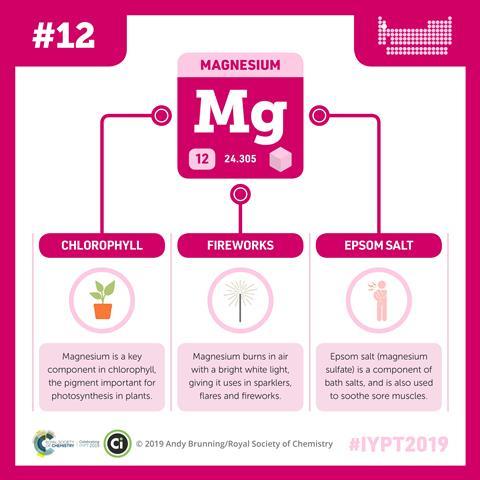
The metal itself is being produced in increasing amounts. It was originally introduced for racing bicycles which were the first vehicles to use pure magnesium frames, giving a better combination of strength and lightness than other metals. (A steel frame is nearly five times heavier than a magnesium one.)
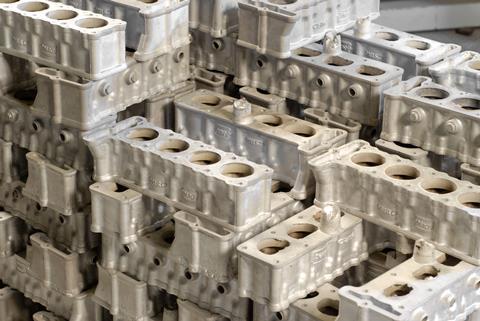
For use as a metal, magnesium is alloyed with a few percent of aluminium, plus traces of zinc and manganese, to improve strength, corrosion resistance and welding qualities, and this alloy is used to save energy by making things lighter. It is found in car and aircraft seats, lightweight luggage, lawn mowers, power tools, disc drives and cameras. At the end of its useful life the magnesium in all these products can be recycled at very little cost. Because it is an electropositive metal, magnesium can be act as a 'sacrificial' electrode to protect iron and steel structures because it corrodes away preferentially when they are exposed to water which otherwise would cause rusting.
Chris Smith
So better bikes, better bombs and better bums. Thank you very much to science writer John Emsley for telling the tale of magnesium. Next week the illuminating story of the element that spawned a light bulb but really needs to work on its image.
Quentin Cooper
If any element needs a change of PR this is the one. It's brittle, prone to ponginess and arguably the dunce of the periodic table. Even the man who discovered osmium treated it rather sniffily. It reeked – or at least some of its compounds did. Tennant described the 'pungent and penetrating smell' as one of the new element's 'most distinguishing characters.' So he called it osmium – osme being the Greek for odour.
Chris Smith
That's Quentin Cooper who will be undressing osmium for us in next week's Chemistry in its element, I hope you can join us. I'm Chris Smith, thank you for listening, see you next time.

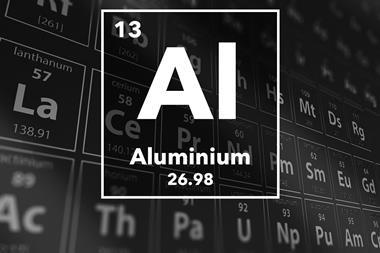
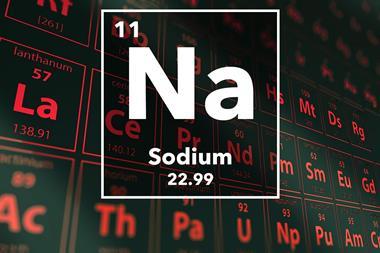










No comments yet